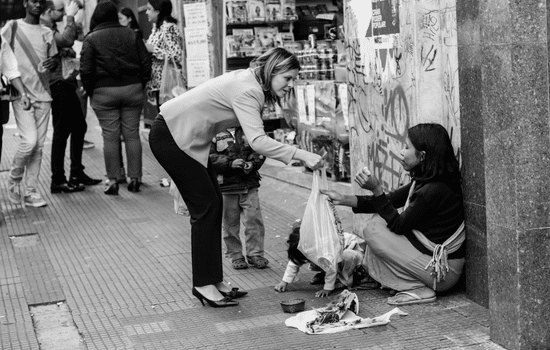Advertisements
Social inequality refers to the unequal distribution of resources, opportunities and privileges between different groups in society.
It exists for several reasons, including:
Advertisements
Economic factors:
The unequal distribution of wealth and income is one of the two main contributors to social inequality.
As people who have access to more resources, such as education, employment opportunities and financial security, they are more likely to have better outcomes and life experiences.
Advertisements
Political Factors:
Political systems, policies and institutions can reinforce or perpetuate social inequality.
For example, discriminatory laws and policies may restrict access to resources and opportunities for certain groups, while favoring others.
Cultural Factors:
Social norms, beliefs and attitudes can also contribute to social inequality.
As a preconception and discrimination based on race, gender, sexual orientation and other factors we can limit opportunities and create barriers for marginalized groups.
Structural factors:
Structural inequalities, such as institutionalized racism, sexism, and heterossexism, can perpetuate unequal power dynamics and restrict access to resources and opportunities for marginalized groups.
Social inequality has been a persistent and widespread characteristic of human societies throughout history.
Evidence of unequal distribution of resources, opportunities and privileges can be found in practically all civilizations, from ancient societies to modern times.
See also:
Everything about social inequality
The impacts of smoking on health and quality of life
Unveiling the History of Social Inequality
In ancient civilizations, such as Greece and Rome, social inequality was characterized by slavery, service and a rigid hierarchy of social classes.
Wealth and power were concentrated among the ruling elite, while the majority of the population lived in poverty and had limited access to resources and opportunities.
During the Middle Ages, feudalism dominated much of Europe, with senors and monarchs holding significant power and wealth, while the majority of the population was servos and peasants with few rights or freedoms.
This pattern of inequality persists during the Renaissance in the modern era, as the increase in industrialization and the growth of capitalist economies leads to greater wealth disparity.
In the 19th and 20th centuries, social inequality assumed new forms as colonialism and imperialism spread throughout the world, leading to exploration and oppression of colonized populations.
At the same time, women, heartfelt people and other marginalized groups will continue to suffer discrimination and exclusion in many societies, despite the efforts of social movements and reforms aimed at promoting equality.
Taking a stand against social inequality in the last few days
Despite significant progress in some areas, social inequality continues to be a present issue in many parts of the world today.
Wealth disparities, or unequal access to education and health, and persistent discrimination continue to limit opportunities and life chances for marginalized groups, perpetuating cycles of poverty and inequality.
As people suffer from social inequality, it is harmful in several ways.
Some two most significant impacts on leaf days include:
Reduced opportunities:
Social inequality restricts access to resources, opportunities and privileges, leading to reduced life opportunities for marginalized groups.
Resulting in lower levels of education, employment and income, such as limited access to health care, moradia and other essential services.
Health disparities:
There may be a direct impact on health, with marginalized groups presenting higher rates of chronic diseases, mental health problems and early death.
This is due to lack of access to quality health care, safe housing and healthy nutrition, as well as exposure to toxic environments and stress.
Economic instability:
It also harms economic stability, leading to greater income volatility, poverty and reduced economic mobility.
This may result in greater financial insecurity and reduced opportunities for upward mobility, especially for marginalized groups.
Deprivation of political rights:
It ends up leading to the deprivation of political rights and the exclusion of decision-making processes, resulting in a lack of representation and responsibility for marginalized groups.
It may further reinforce existing power imbalances and restrict opportunities for systemic change.
Social Tension:
Social inequality can create social tension, conflict and division, as marginalized groups are deprived of equal opportunities and reconstitution.
Consequently, it ends up leading to social unrest and undermining the harmony and trust of the community.

Facing social inequality head-on!
The fight against social inequality requires a complex approach that addresses the deep causes and systemic factors that perpetuate.
Some ways to combat social inequality include:
Addressing economic inequality:
Policies and economic initiatives that promote greater equality of income, minimum wage laws and acessible moradia
Or that it can help reduce wealth disparities and improve access to resources for marginalized groups.
Promotion of educational equity:
Invest in quality education for all, especially in needy communities,
This will help reduce educational disparities and provide equal opportunities for individuals to achieve their full potential.
Defending political representation:
Ensure that marginalized communities have representation and voice in political decision-making processes.
That there is democracy, this helps to reduce the deprivation of political rights and promote greater responsibility.
Lidando como o viés institutional:
Challenge and dismantle institutionalized forms of prejudice and discrimination, such as racism, sexism and heterossexism.
It can help reduce systemic barriers that restrict opportunities for marginalized groups.
Support social movements:
Supporting and amplifying the voices of two social movements that work to promote equality and justice can help increase awareness, create momentum, and drive change.
Encourage diversity and include:
Promote diversity and inclusion in all aspects of society, from the workplace to the communities and abroad.
What it will mean is creating a more inclusive and equitable society, where everyone has equal opportunities to prosper.
The unequal reality of society.
Social inequality is detrimental to individuals, communities and society as a whole.
Addressing this is essential to promote justice, equity and well-being, and to build more inclusive and equitable societies.
It is a complex and challenging quest, but by working together and seeking open solutions, we can create more inclusive and egalitarian societies.
In conclusion, social inequality is a complex question that exists due to a combination of historical, economic, political, cultural and structural factors.
Addressing social inequality requires systemic changes and continuous efforts to challenge and dismantle the systems and structures that perpetuate them.




